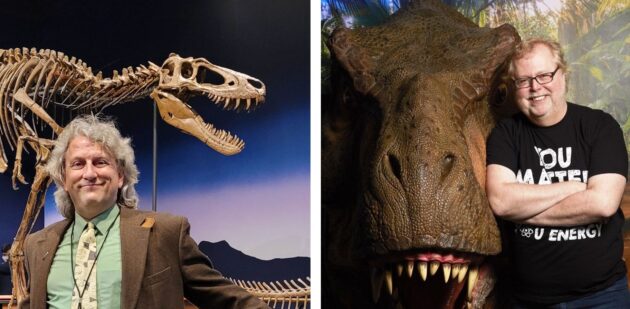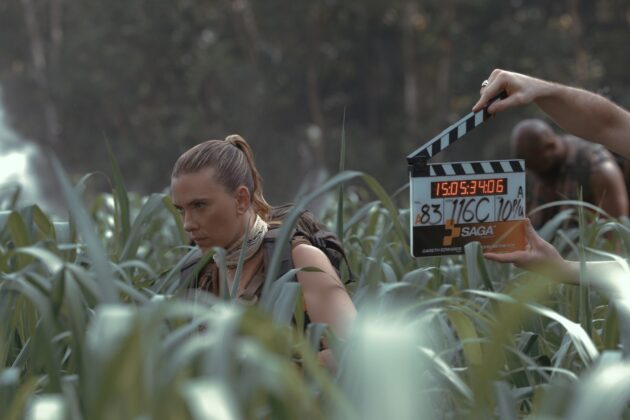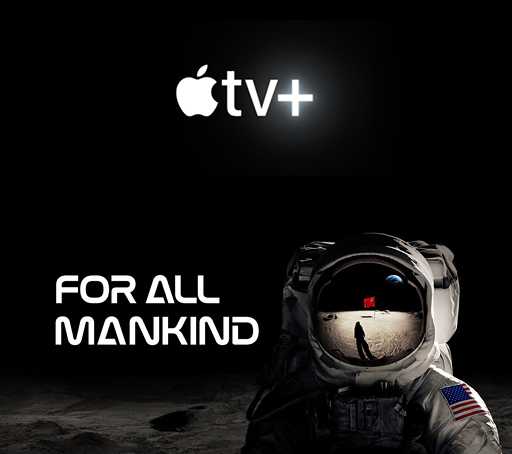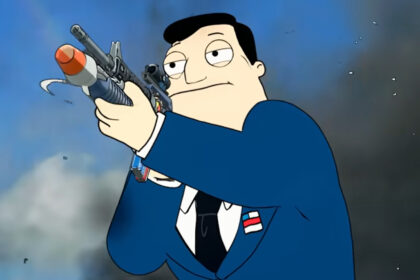Nathan Myhrvold, a Seattle tech titan who also studies titanosaurs and other denizens of the dinosaur era, realizes that “Jurassic World: Rebirth” is science fiction, not a documentary — nevertheless, he has a few bones to pick with the filmmakers.
“There are some lines that it would be silly to cross, but they did anyway,” says Myhrvold, who was Microsoft’s first chief technology officer back in the 1990s and is currently the CEO of Bellevue, Wash.-based Intellectual Ventures.
Paleontology is one of Myhrvold’s many interests, and he’s a co-author of more than a dozen peer-reviewed papers on the subject. He was inspired to get into dinosaur research almost 30 years ago, when he visited a “Jurassic Park” movie set at the invitation of director Steven Spielberg. That visit led to connections with leading paleontologists.
“At that point in my life, I was interested in dinosaurs, but I’d never been professionally or seriously, in a scientific sense, into dinosaurs,” Myhrvold recalls. “So, the movie was a little bit instrumental in me, just as a way of meeting a bunch of those people.”
On the latest episode of the Fiction Science podcast, Myhrvold and University of Maryland paleontologist Thomas Holtz discuss how much scientists — and filmmakers — have learned about dinosaurs over the past three decades. And they also critique “Jurassic World: Rebirth,” the latest offering in a multibillion-dollar movie franchise that was born back in 1993.
Holtz, who specializes in the study of meat-eating dinosaurs like the ones that grab the spotlight in the movie, is a co-author of the educational field guides for the early “Jurassic Park” movies as well as the “Jurassic World” sequels that followed. He’s also been a scientific consultant for dino-documentaries including the BBC’s “Walking With Dinosaurs” series and the Discovery Channel’s “When Dinosaurs Roamed America.”
He argues that the Jurassic movies elevated the general public’s long-running fascination with dinosaurs to a whole new level.
“There was a time when no one but paleontologists had ever heard the word ‘Velociraptor,’ and that time was 1993,” Holtz says. “Prior to that, the general public would have never heard of this particular sort of dinosaur, which is now by far one of the most common.”
“Jurassic Park” reflected the state of the art for dinosaur science when it came out, and the special effects have only gotten better with each sequel. But Holtz admits that the movies’ depictions of dinosaurs haven’t always kept pace with what paleontologists have discovered.
“I’ve talked with special-effects people who’ve been involved with some of these movies, and they said, yes, they would like to run a little more wild, a little more modern,” Holtz says. “But there is the pressure to have the look and feel of a Jurassic World / Jurassic Park franchise dinosaur. And you know, that’s kind of a shame.”

There are several ways to go wild with dinosaurs. For example, fossil specimens that were unearthed in China’s Liaoning Province in the 1990s confirmed that non-avian dinosaurs had feathers. And when scientists studied fossilized traces of microscopic structures known as melanosomes, they determined that dinosaurs came in different colors. Such traits aren’t seen so much in the creatures of “Jurassic World.”
“They did start to add patches of colors in more of the dinosaurs in the ‘Jurassic World’ series,” Holtz says. “The raptors — although they’re not feathered as they should be, they at least have more interesting colors on them. In fact, Blue gets its name because of the blue streaks down its body.”
Myhrvold wishes the filmmakers had included some of the more bizarre species that paleontologists have turned up in the fossil record. One such species is Microraptor gui — a type of raptor that was discovered in the early 2000s and had four wings with black feathers.
The goal of the people making the movie is to be entertaining, not to satisfy all the whims of us paleontologists.
Nathan Myhrvold
“There are insects with four wings, like dragonflies, but there aren’t any birds,” Myhrvold says. “Deinocheirus … that’s another raptor relative that everyone thought was going to be the most vicious-looking dinosaur on earth because they found the claws and the arms in the 1970s. They finally found the rest of it, and it turns out it has a face like a horse. There are things like that, that would be cool to see more of … but you know, the goal of the people making the movie is to be entertaining, not to satisfy all the whims of us paleontologists.”
Some of the dinosaur depictions in the latest movie are debatable. For example, one scene has a school of spinosaurs with colorful sails menacing a ship and its occupants on the open sea. Both Myhrvold and Holtz have played a part in research arguing that spinosaurs couldn’t possibly behave that way.
“I believe, and I know Tom believes, that Spinosaurus was a shoreline animal,” Myhrvold says. “It undoubtedly ate fish, but you can eat fish without swimming 43 kilometers offshore. Grizzly bears eat fish, and they don’t swim offshore if they can help it. Now, admittedly, that’s controversial.”
Another slight misstep has to do with titanosaur tails. One scene in “Jurassic World: Rebirth” shows a flock of titanosaurs flicking long, sinuous tails as they graze. Myhrvold actually conducted research into dino-tails, focusing on whether some dinosaurs could whip their tails at supersonic speeds. To show that they could, he went so far as to have a mechanical tail built that could simulate the whipping action.
Unfortunately, titanosaurs didn’t have the type of tail that’s shown in the movie. “When I saw the long tail, I first thought, hey, this can’t be a titanosaur,” Myhrvold said. “And then I thought they’re going to crack it supersonically, and I would forgive everything else.”
Myhrvold argues that it’s worth the effort for science-fiction movies to stay as close to the science as possible, with limited exceptions for entertainment value.
“There are movies that really do pride themselves on getting details right — details of spycraft, details of weapons, details of historical facts — and then they spend their suspension-of-disbelief items on a smaller set of things,” he says. “They’re rewarded in having those details be accurate with a lot of people loving that.”
The basic premise of the “Jurassic Park” and “Jurassic World” movies is broad enough to give the filmmakers plenty of literary license. If you’re able to reconstruct dinosaur species from bits of DNA, you should be able to mix and match that genetic code to create new hybrid species.
In the “Rebirth” movie, Scarlett Johansson and a team that includes a greedy business executive and a virtuous paleontologist have to grab blood samples from genetically altered dinosaurs that were too dangerous to be set loose, but too expensive to kill. “The worst of the worst were left here,” says the executive (played by Rupert Friend).
The idea of resurrecting extinct species from their DNA isn’t nearly as far-fetched as it sounded back in 1993: Today, commercial ventures including Colossal Biosciences are working on ways to create modern-day versions of dire wolves, woolly mammoths and even woolly mice. But those efforts pale in comparison with the over-the-top creatures created by the filmmakers behind the “Jurassic World” movies.
Two made-up species take the spotlight in “Rebirth”: Mutadon, which is a cross between a velociraptor and a pterosaur; and Distortus rex, a monster with six arms and an oversized, misshapen head.
Myhrvold thinks it’s unnecessary to make up imaginary monsters. “The part that is funny to me about this is that there are lots more dinosaurs,” Myhrvold says. “It turns out, in most cases, the actual fossil record of Earth is more interesting than made-up creatures.”
The real-world technology of paleontology isn’t quite as advanced as the fictional technology of “Jurassic World,” but it’s come a long way since 1993. Holtz noted that CT scans of dinosaur skulls “have revealed lots of information about their brain cavities and nerve passages … which were extremely difficult to try to see before.”
“Isotopic studies of the bones and teeth can tell us something about what they were feeding on,” Holtz said. “Very clever geochemists and biogeochemists have been able to tease out organic goo from fossils in a way that tells us something about certain aspects of their physiology.”
Even artificial intelligence comes into play. Holtz noted that some paleontologists are using AI tools to classify their fossil specimens. “Machine learning might be able to pick up things that we don’t immediately think of,” he said. “So far, that’s been the main use of it I’ve seen professionally, but it’s still early days. We’ll see where this technology goes in the future.”
How much of a future is there for paleontology — and for the “Jurassic World” franchise? Will there come a time when dinosaur movies go extinct? During the opening scenes of “Jurassic World: Rebirth,” we learn that the general public has become so bored with dinosaurs that the museums are shutting down their exhibits.
“Sorry, I find that deeply unrealistic,” Myhrvold said. “That was maybe the most unrealistic thing in the film. You can give me a six-legged dinosaur, OK? Don’t tell me no one’s gonna like dinosaurs, because dinosaurs have the great additional feature that they’re real. And at some level, the fact that they’re real keeps bringing them home again.”
Dino bites
Mini-review: Setting aside their scientific qualms, Holtz and Myhrvold give two thumbs up to “Jurassic World: Rebirth” for its entertainment value. “This is not a film that’s supposed to be deeply philosophical. This is a film that’s supposed to show you lots of action, lots of thrilling sequences, and dinosaurs eating people. And as long as you check each of those, hey, you’re there,” Myhrvold says. Holtz adds that the movie has another key element for dinosaur movies: children at risk. Myhrvold agrees: “Not only do dinosaurs have to eat people … they have to almost eat children, right? If they did eat children, I think that would be off-putting.”
The next ‘Jurassic’ movie? Deadline reports that “Jurassic World: Rebirth” has gotten off to a “stomping good start,” and it seems as if the path is open for yet another sequel. “I bet you could build a story around the dinosaur field biologist who’s not working with fossils or bones in plaster jackets — they’re working with live animals, but trying to figure out cool things about them,” Myhrvold says.
Delve deeper into dinosaurs: Check out Myhrvold’s detailed analysis of what “Jurassic World: Rebirth” got right and wrong about paleontology, which also includes a lineup card for the movie’s creatures. Holtz provides his own perspective on facts vs. film fiction in a report from the University of Maryland. And for the full treatment, you can turn to the Jurassic World Dinosaur Field Guide, which Holtz had a hand in writing; or “The Rise and Fall of the Dinosaurs,” which was written by paleontologist Steve Brusatte, a science consultant for “Jurassic World: Rebirth.”
Fiction Science is included in FeedSpot’s 100 Best Sci-Fi Podcasts. Stay tuned for future episodes of the Fiction Science podcast via Apple, Spotify, Player.fm, Pocket Casts and Podchaser. If you like Fiction Science, please rate the podcast and subscribe to get alerts for future episodes.
Read the full article here










